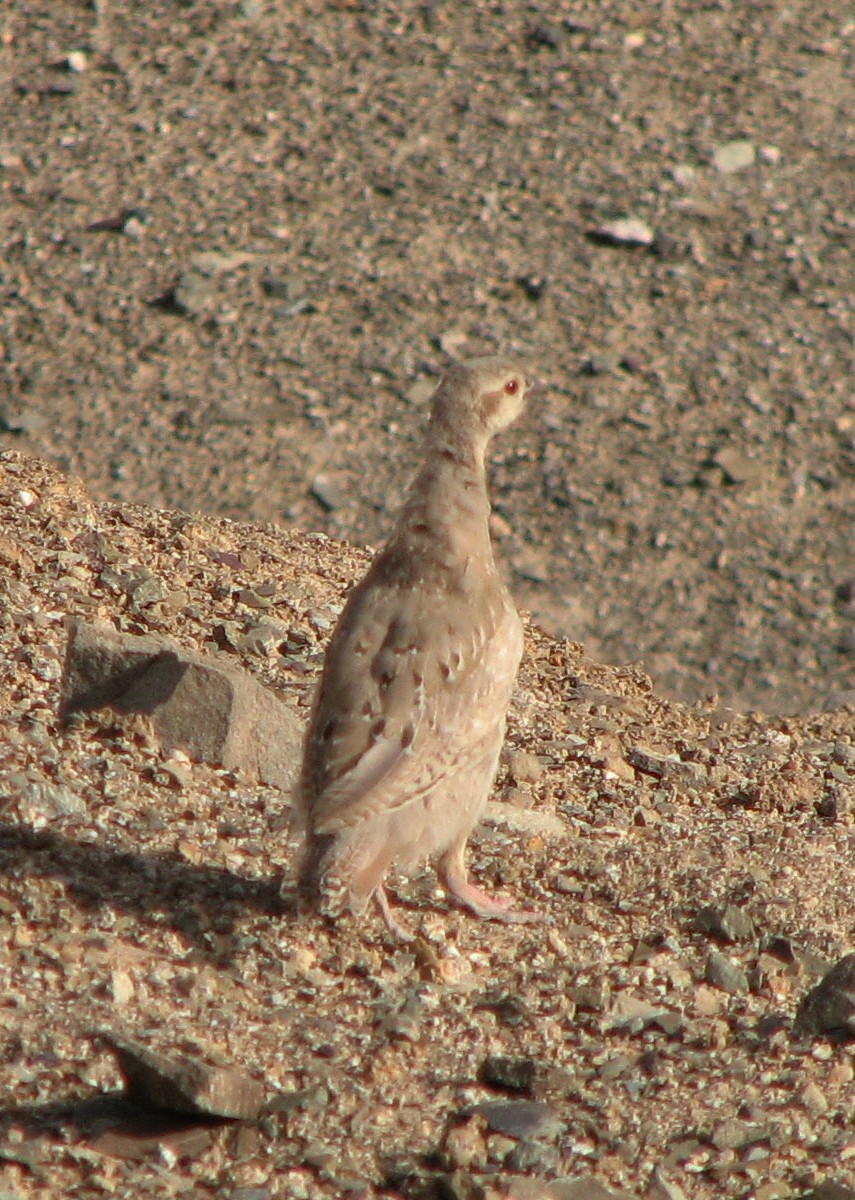Chukar
A species of Rock partridges, Also known as Chukor Scientific name : Alectoris chukar Genus : Rock partridges
Chukar, A species of Rock partridges
Also known as:
Chukor
Botanical name: Alectoris chukar
Genus: Rock partridges
Content
Description People often ask General Info
Description
The chukar has a light brown back, grey breast, and buff belly. The face is white with a black gorget. It has rufous-streaked flanks, red legs and coral red bill. Sexes are similar, the female slightly smaller in size and lacking the spur. The tail has 14 feathers, the third primary is the longest while the first is level with the fifth and sixth primaries. Their song is a noisy chuck-chuck-chukar-chukar from which the name is derived. 
Size
36 cm
Life Expectancy
3-5 years
Nest Placement
Ground
Clutch Size
10 - 21 eggs
Incubation Period
1 brood
Feeding Habits
Chukar primarily consume seeds and leaves of annual and perennial grasses, notably introduced cheatgrass, as well as pinyon pine, sunflower, rough fiddleneck, and tansy mustard. Their diet also includes berries and insects, with green grass leaves being a main food source in late fall and winter. Chicks mainly eat insects.
Habitat
Chukar are typically found in rocky, arid regions including hillsides, mountain slopes, and canyon walls. These birds prefer elevations between 4,000 and 13,000 feet in dry high-elevation shrublands, often characterized by steep, rocky terrain with a combination of brush, grasses, and forbs. Big sagebrush often dominates the vegetation of their territory and is a key part of their diet. Chukar usually require proximity to water sources and may travel towards agricultural fields or urbanized areas during harsh winters for sustenance.
Nest Behavior
Females primarily manage nest building and incubation, with occasional help from males. Chukar engage in nest tending during the nesting season, reflecting their dedication to parental care.
Nest Characteristics
Chukar nests are shallow depressions with a lining of dry grasses and breast feathers. Typically located near rocks or brush on slopes, or under sagebrush or desert shrubs, they measure about 8 inches in diameter and 2 inches in depth.
Dite type
Granivorous
General Info
Feeding Habits
Bird food type
Behavior
The chukar predominantly spends its time terrestrial, with flight being a short-range response to perceived threats. Baleful and communicative, these birds serve as vigilant observers for danger, employing distinct calls to signal the presence of predators, both terrene and aerial. At dusk, chukar roost on the ground, seeking shelter under flora or stones. These monogamous creatures engage in territorial behavior during mating seasons, with males initiating courtship through a series of calls and elaborate displays, including a variety of striking poses and movements. Although males typically depart post-egg-laying, a minority remains to aid the brood. Exhibiting a social disposition, chukar frequently assemble into familial aggregations known as coveys, which may expand to multiple kinship groups or include single adult birds. In arid conditions, these coveys might persist throughout the year, with breeding occasionally taking a hiatus.
Distribution Area
This partridge has its native range in Asia, including, Syria, Palestine, Israel, Lebanon, Turkey, Iran, Afghanistan, Pakistan and India, along the inner ranges of the western Himalayas to Nepal. Further west in southeastern Europe it is replaced by the red-legged partridge, Alectoris rufa. It barely ranges into Africa on the Sinai Peninsula. The habitat in the native range is rocky open hillsides with grass or scattered scrub or cultivation. In Israel and Jordan it is found at low altitudes, starting at 400 m (1,300 ft) below sea level in the Dead Sea area, whereas in the more eastern areas it is mainly found at an altitude of 2,000 to 4,000 m (6,600 to 13,100 ft) except in Pakistan, where it occurs at 600 m (2,000 ft). They are not found in areas of high humidity or rainfall. It has been introduced widely as a game bird, and feral populations have become established in the United States (Rocky Mountains, Great Basin, high desert areas of California), Canada, Chile, Argentina, New Zealand and Hawaii. Initial introductions into the US were from the nominate populations collected from Afghanistan and Nepal. It has also been introduced to New South Wales in Australia but breeding populations have not persisted and are probably extinct. A small population exists on Robben Island in South Africa since it was introduced there in 1964. The chukar readily interbreeds with the red-legged partridge (Alectoris rufa), and the practice of breeding and releasing captive-bred hybrids has been banned in various countries including the United Kingdom, as it is a threat to wild populations. 
Species Status
Not globally threatened.
